Agave: features, types and growing at home

For all the beauty and benefits of plants familiar to Russians, it is useful to know about exotic ornamental crops. Each of them has its own characteristics. But having found out exactly the specifics of the same agave, gardeners and florists will save themselves from many mistakes.

What does it look like and where does it grow?
Agave is a succulent plant often confused with cactus or aloe. Despite the external similarity, agave has a number of unique properties. Water is collected in the tissues of the plant, which makes it possible to successfully endure even difficult conditions. The corresponding special tissues are located in the thick, fleshy-looking leaves. Basically, they are attached to a dense stem.
The main habitat of agave in natural conditions is South America, Mexico and the southwestern states of the United States. This is not a specific species, but a whole genus, numbering dozens of individual species. Agave pulp is significantly sweeter than sugar. On many plants, the foliage is covered with thorns and forms a rosette. Peduncles are long enough.
The descriptions note the great length of the peduncles, as well as the fact that the agave blooms only once in its entire life. It is possible to grow this plant on the southern coast of the Crimea and in other places on the Black Sea coast. However, there it is noticeably less than at home. Agave is mainly used as a houseplant. But in Mexico and other countries of the Western Hemisphere, other features are also actively used.



So, agave is used:
- for the treatment of a number of infections;
- for food purposes (young foliage);
- in the construction of roofs;
- in the production of coarse fabrics;
- in the manufacture of arrowheads;
- for the preparation of local alcoholic beverages;
- in the production of hammocks, sails, brushes.




Agave lives in arid areas. It differs from cacti in that it forms well-developed fleshy leaves. As stated in a number of publications, the stem as such in this plant is absent. Only occasionally can you find shortened stems. But a powerful spreading outlet is formed.
Wild agave sometimes reaches a diameter of 2 m. The leaves are also quite long, colored in different shades of green. The end of the leaf is a thin tip. Wild agaves bloom much more readily than artificially cultivated ones, but the latter are more decorative. They can be grown even in apartments, and at the same time leaving does not cause any particular problems.



Is it a cactus or not?
The answer to this question is negative, which is very important for flower growers. The approach to agave should be different from that of growing cacti. According to modern concepts, it belongs to the asparagus family from the order of asparagus plants. Additionally, the agave subfamily is distinguished, which also includes:
- corolla;
- beshorneriya;
- camassia;
- erreria;
- hesperaloe;
- host;
- yucca.
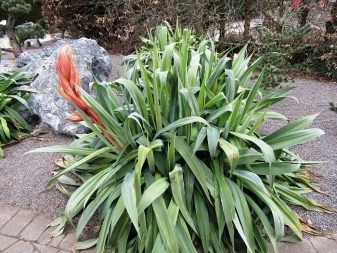



Views
The most popular among the agave varieties in our country is Americana. Its bushes have a stem up to 0.3 m long. A basal rosette is formed from the leaves. The height of the American agave reaches 1-2 m. Since the diameter can be 3 m, the plant can only be grown in spacious rooms.

Queen Victoria agave forms a rosette with a diameter of up to 0.6 m. In this case, the length of the foliage ranges from 0.1 to 0.15 m, and their width is from 0.05 to 0.07 m. Flowers are painted in dark green tones. Among the names of agave, filufera is often heard.The edges of the foliage of this plant are covered with dry fibers, and the rosette does not exceed 0.5 m.

The American yellow-edged agave is very resistant. Another advantage of this plant is its compactness... It is grown even in simple sandy soil - this will not affect the rate of development.

In terms of aesthetic properties, the most attractive is blue (aka Mexican or tequila) agave. The color of the plant is already clear from its name. The main habitat is the deserts of Mexico. The alternative "name" is due to the fact that this culture is used for the production of tequila. As a houseplant, the blue agave wild plant is not used, but there are many decorative subtypes that are quite similar in appearance to the original plant.
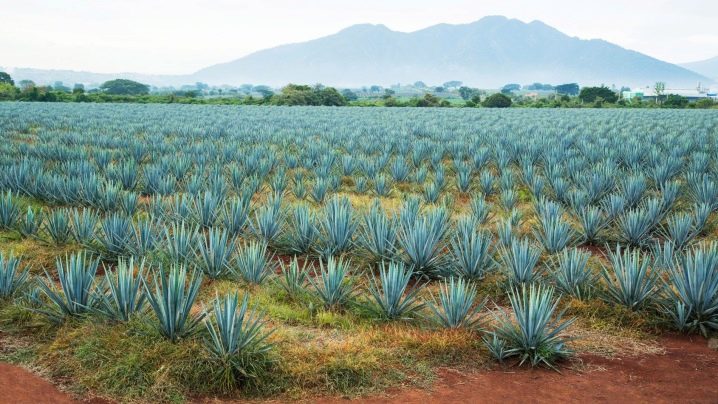
The striped (aka multi-colored agave) is rather small in size. That is why it is recommended for potting. The geometry is roughly the same as the American version. White and yellow stripes of small width are located in the middle of the leaves. The requirements for the work of gardeners are relatively simple, only spraying is required in winter.
You can grow striped agave even in very poor soil, but you will need to provide significant light. You will also need to create a drainage layer.

Filamentous agaves have earned their name because of the mass of white filaments that cover the foliage. Filamentous fibers are formed directly from the leaves. The foliage is relatively thin and grows up to a maximum of 0.2 m. This makes the plant quite suitable for growing in a room.
The upper parts of the leaves are covered with gray or brown thorns. The growth of the filamentous agave can be very fast, but this will require the creation of suitable conditions. In winter, it is successfully kept at temperatures from 4 to 10 degrees Celsius.

Agave marginata outwardly resembles a striped variety, however, it is better suited for home growing. The fleshy leaves are colored green. The edges of these leaves are yellow or white. Deserves attention and tree agave, however, there is no information about it in popular sources and flower growers need to be very careful not to get a "pig in a poke".

Better to take a closer look at the funk agave. This species is relatively small and forms rosettes up to 1.5 m in diameter. The foliage is colored gray-green. The base of the leaf is narrower than the middle, and the top is also quite narrow. The thorns located on the sides of the leaf plates are colored in the same way as the leaf itself.

The potato-like variety, sometimes called potatorum, is very decorative. However, it is undeservedly ignored by flower growers. The diameter of the leaf rosette does not exceed 0.25 m, so the plant looks quite attractive even in small rooms. Its foliage resembles a shovel, but there are specimens with obovate leaves.

A bluish waxy coating is deposited on the gray-green surface of the leaves. The end of the leaf always has dark red spines. Similar spines cover the crenate edges of the leaves. There is also Agave Potatorum Fershaffelt. Its structure is the same, but at the top the leaf is painted in pink tones.

Amateur flower growers often ask which agave is the most original. It is unlikely that it will be possible to give an exact answer to this question. But one of the right candidates will be condensed variety... The leaves of this plant are not wide, and dense rosettes resemble a ball in shape. The culture is branching, in a few years it will turn into a multi-outlet form and cover a significant territory.
Conditions of detention
Agave, as is already clear, does not require particularly difficult maintenance... But you should still take into account the basic rules for growing this crop. It should be remembered that it will never be as large as in the wild at home. Since the plant belongs to succulents, it must be placed in the lightest areas. A solar window will work very well.
The south side of the house is even better. But when extreme heat sets in, one must carefully avoid wetting the leaves. Otherwise, burns may occur. In partial shade, as well as on the northern windows, agave can gradually lose vitality, but it is not immediately possible to detect this problem.
Important: if there is not enough light in winter, the plant will stretch in length, while the leaves of the indoor flower become smaller. If the lighting is organized well, they are densely grouped. It should be remembered that an abrupt transfer of agave from a shaded place to a lighter one is unacceptable. The plant must adapt to such conditions.

But the thermal regime is not so important. Therefore, in the summer months they try to transfer the pots to the open air. If for any reason this cannot be done, you will have to ventilate the room more often. This technique will avoid the harmful effects of temperature changes.
Agave feels pretty good at a temperature of 18 degrees. The best conditions, however, are in the range of 22 to 28 degrees.
For your information: in winter, the room where the agave is grown should not be cooled to more than -6 degrees. This is already a critical temperature, and a ten-degree frost can completely destroy a delicate tropical culture. Air humidity is not too important. Even if it is only 40%, there is no need to specifically increase it.
Planting is carried out in those mixtures that are close to a layer of sand and stones that is poor in nutrients. Of the self-prepared soil formulations, a combination is best suited:
- humus;
- washed sand of coarse fractions;
- leafy land;
- turf.
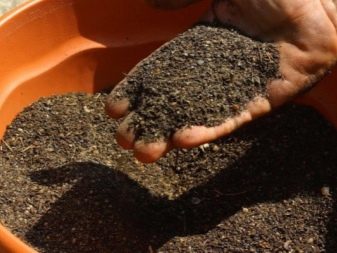
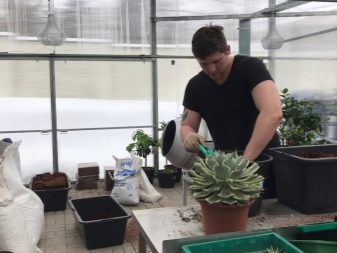
Their relative amount is 1 part, 0.5 part, 1 and 2 parts, respectively. If there is no desire or opportunity to prepare the soil mixture on your own, you can take store-bought soils designed for palm, yucca or dracaena. According to qualified florists, it is worth laying out a brick broken into large pieces on top - it will strengthen drainage. The optimal containers are ceramic pots, which are characterized by a large diameter and low height.
There must be drain holes in the bottom. At the very bottom, 0.02-0.03 m of gravel or other small stones are placed.
Important: they should be thoroughly washed and disinfected. A freshly planted agave is not placed in the sun, first it must take root and get stronger.


Reproduction and transplantation
Seeds are sometimes used to propagate room agave, but this method is difficult to consider optimal - the development rate is too low. In the last days of winter, you need to put the seeds in wet sand, burying them about 0.01 m. Immediately cover the container with a transparent film or glass. Inside, the temperature must be maintained from 20 to 25 degrees.
Seedlings should be expected 5-7 days after planting. Then, on the 15-20th day, the second leaf should come out, on the 35-40th day - the third; by the end of the second week thereafter, the agave grows to 0.08 m in height. In this case, its diameter is 0.15 m. The rosette is formed at the moment the fourth leaf appears.


If it is decided to use cuttings, they must be cut off near the base. At least one bud should remain on the cuttings, otherwise the plant will not take root. Next, the workpieces must be dried for 2 or 3 hours. To speed up growth, the cut points are sprinkled with crushed charcoal.
As time goes on, you can prepare the soil or sand. Plantings are watered with water at room temperature. In the first 12 months, 5-6 leaves can form. In the second year of life, up to 9 new leaves will appear, and in the third - up to 12.
Indoor agave can be propagated by side and root suckers. This method is also relatively simple. As soon as the babies appear, they must be separated with a sharp blade. Drying of harvested seedlings takes about 24 hours, no covering and spraying is required.For the first time, you need to water the plant on the third day; frequent watering is not recommended until complete rooting.
The transplant can be done once a year. In an older age, this procedure is carried out after 2-3 years, or if the pot has clearly become small. You can transplant sprouts grown by the seed method in a container 0.06 m wide.Next year, you will need pots 0.08 m wide.
Root necks should not be buried. Better if they stay above the surface. A common mistake when replanting agave is soil compaction.


It is recommended to fix the rosette with stones - this solution will activate the supply of oxygen to the flower. Nothing else is required from the florists at this stage.
Care
The easiest way to grow at home is a whitish, royal or thread-bearing agave variety. In addition to the usual procedures such as watering, maintaining light and feeding, you will need to systematically clean the leaves. They collect dust that can disrupt photosynthesis when neglected.
When growing agave, it is watered a maximum of two times in 10 days. At the same time, make sure that the surface of the earth is dry, but not excessively dry. When the growing season ends, watering becomes even less frequent - even once a month is enough.
Spraying this plant is unacceptable. If the center of the outlet gets wet, it will start to rot.

Agave is fed every 14 days, but only in summer, and not during flowering. For top dressing, formulations with a limited nitrogen content are recommended. You can just take mixtures for fertilizing succulents. Experts and experts agree that a deficiency of nutrients is less dangerous for agave than an overabundance.
Taking care of a flower also means being attentive to it at an early stage of development. It is undesirable to move the agave at this time, unless only to change the illumination. In the first few weeks after planting or transplanting, the roots are very sensitive. You should not loosen the soil again, and ideally, you should completely abandon loosening.
If you really need to transplant a flowering agave immediately, it is best to get rid of the flower, as it absorbs a lot of vitality.


Diseases and pests
A tropical succulent plant is not very susceptible to disease, but you must always remember that mistakes in caring for it can harm the plant. Of the pests, the scabbard and thrips are especially dangerous, because of which the plant dries and withers. You can deal with them by washing the leaves:
- a weak alcohol solution;
- soap suds;
- highly diluted beer;
- a weak solution of boric acid.




These natural remedies almost always help. But not the first time, but when processing every 4-5 days. It is necessary to repeat the treatment until the pests completely disappear. If the infestation is very severe, plant-based insecticides should be used. They are used in strict accordance with the directions for dosage, concentration and personal protective measures.
Sometimes lower leaves turn yellowas if in the trees in late autumn. In this case, it is sufficient to reduce the watering intensity.
It is worth remembering that agave can be infected with fungi that cause rotting of roots and leaves. The main cause of infection is too intensive irrigation. It is necessary to ensure that in the intervals between watering the clod of earth dries out completely.

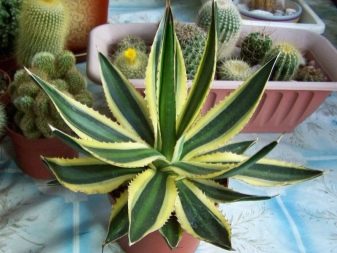
But sometimes this is no longer enough, and the disease worsens. Then you will have to transplant the plant into clean soil. It is even advised to bake it to get a good result. Sometimes agave suffers from mealybug... It is necessary to fight it with the help of insecticides, home remedies will not help here.
For the types, care and reproduction of agave, see the next video.








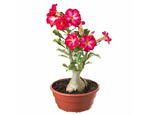




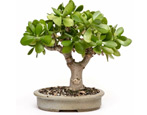




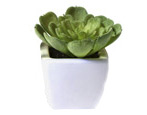








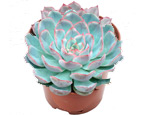






















The comment was sent successfully.